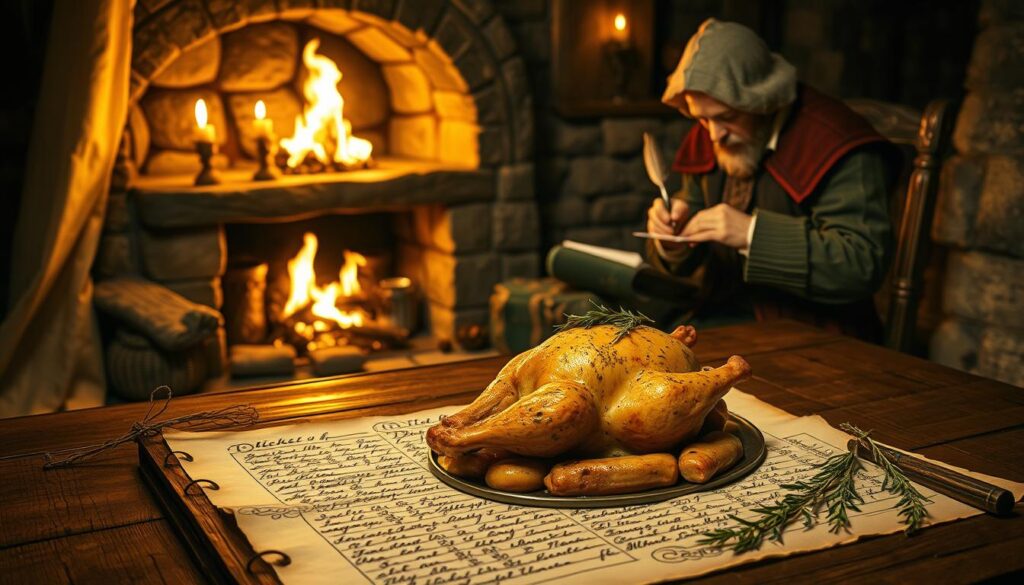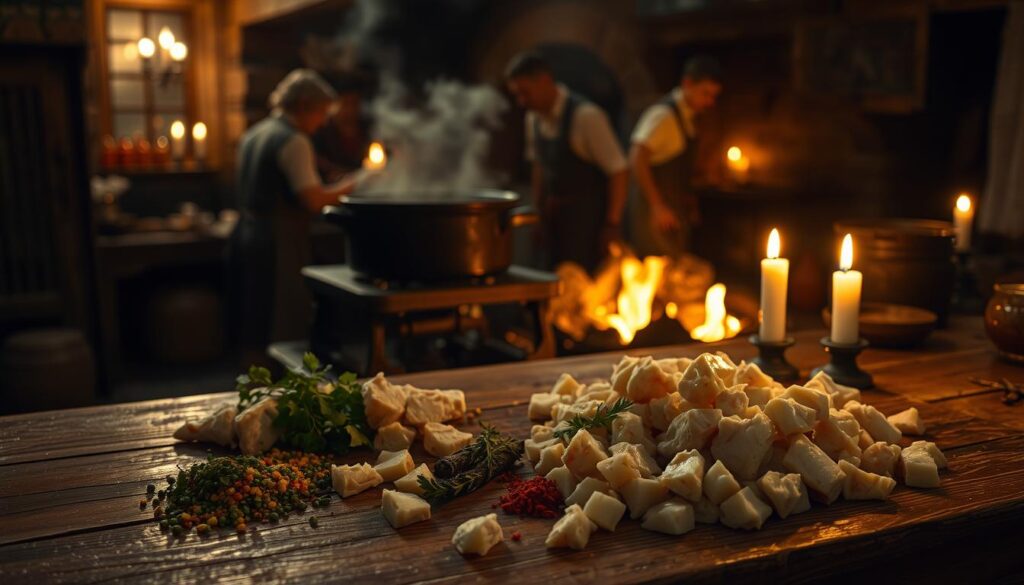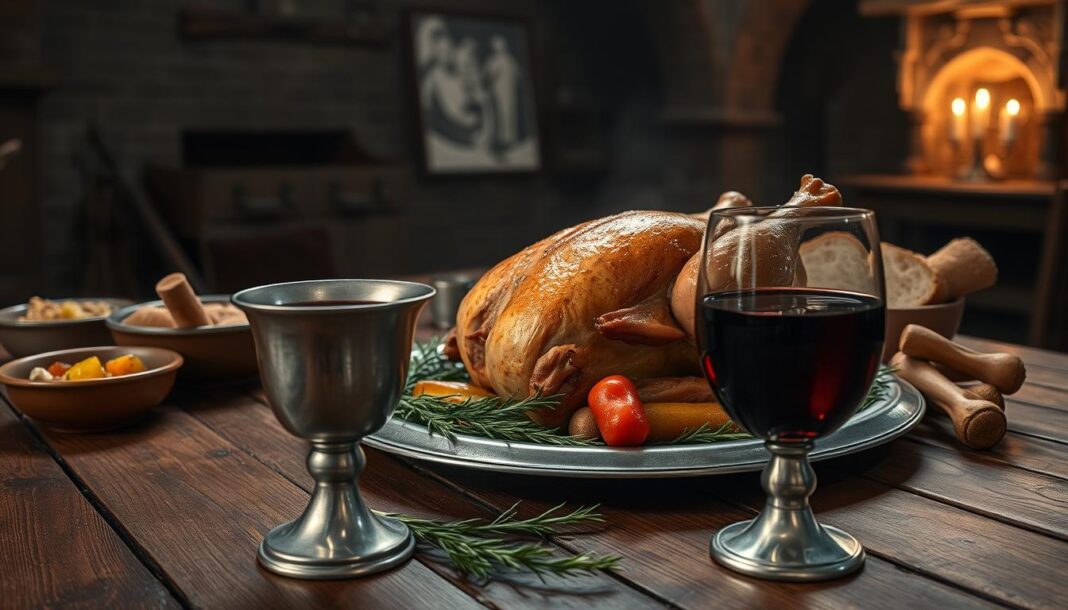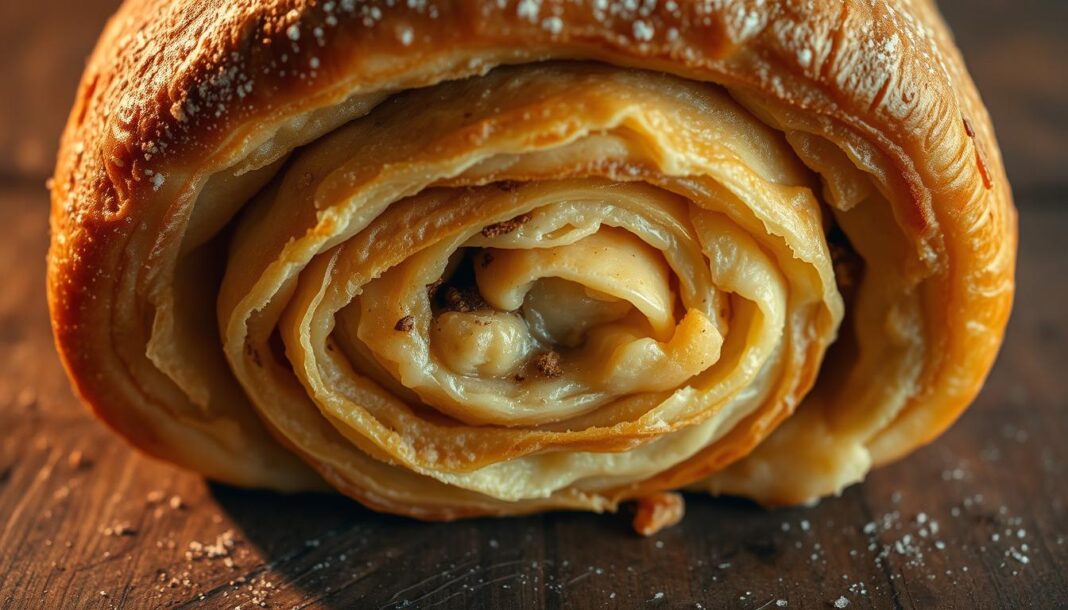We are excited to bring you a historically-inspired medieval chicken recipe that revives the authentic flavors of the 13th century in your modern kitchen.
Our journey into the past reveals a traditional Teutonic chicken dish documented in the Liber de Coquina, a foundational text for Italian medieval cuisine.
By balancing historical accuracy with contemporary cooking methods, we make this ancient recipe accessible to today’s home cooks, offering a unique glimpse into medieval European culinary traditions.
Key Takeaways
- Discover a medieval-inspired chicken dish from the 13th century.
- Learn how historical cooking techniques can be adapted for modern kitchens.
- Understand the significance of the Liber de Coquina in medieval Italian cooking.
- Explore the balance between historical authenticity and modern practicality in cooking.
- Gain insights into medieval European culinary traditions and their lasting influence.
The Origins of Our Medieval Chicken Recipe
In exploring the medieval chicken recipe, we uncover the rich culinary exchange between Italy and Teutonic regions in the 13th century. This historical context provides a fascinating backdrop to our modern interpretation of this ancient dish.

13th Century Teutonic Influences
The medieval chicken recipe is derived from the Liber de Coquina, a cookbook that highlights the culinary practices of the late 13th century. The recipe is labeled as ‘Teutonic,’ indicating its perceived foreign origin in Italy. This labeling not only showcases the cultural exchange but also highlights the adaptability of recipes across different regions.
How Medieval Cooking Differs From Modern Methods
Medieval cooking techniques, such as those used in our chicken recipe, relied heavily on open fires and simple tools, creating distinct flavors. Herbs like rosemary were used not just for flavor but also for their perceived medicinal properties, reflecting the humoral theory that influenced medieval cuisine. This approach to cooking resulted in dishes that were both flavorful and balanced.
- The use of few, high-quality ingredients was characteristic of medieval cooking, as seen in our recipe.
- Medieval cooks relied on experience and judgment rather than precise measurements.
- The emphasis on balance according to humoral theory guided ingredient combinations.
Authentic Medieval Chicken Recipe Ingredients
To recreate our medieval chicken recipe authentically, understanding the original ingredients is crucial. The medieval kitchen was characterized by its use of fresh, locally sourced ingredients, and our recipe is no exception.

Traditional Herbs and Spices
The traditional herb mixture in our medieval chicken recipe includes rosemary, parsley, mint, and marjoram. These herbs were not only chosen for their flavor but also for their medicinal properties. Saffron, an expensive and prized spice, adds both flavor and color to the dish. Salt was used sparingly, balanced with the other ingredients to create a harmonious flavor profile.
Modern Substitutions for Hard-to-Find Ingredients
While traditional ingredients like capon or fat hen are ideal for our medieval chicken recipe, modern substitutions can be made. For instance, a plump chicken can be used as a substitute. When measuring ingredients, using a standard cup measurement helps maintain the balance of flavors. You can also add a piece of fatter meat like mutton or beef for enhanced flavor. If saffron is difficult to find, alternatives like turmeric can be used, though the flavor and color may vary slightly. To measure the ingredients accurately, use one cup as a reference.
Step-by-Step Cooking Instructions
Let’s get started with cooking our medieval chicken recipe, a journey that takes us back in time with every step. To achieve an authentic flavor, we’ll guide you through the complete process, from preparing your chicken to serving the final dish.
Preparing Your Chicken
First, we need to prepare our chicken according to medieval standards. This involves cutting the chicken into appropriate pieces, a technique that differs from modern butchery. Ensuring the pieces are clean and ready for cooking, we add a pinch of salt to enhance the flavor.
Creating the Medieval Herb Mixture
Next, we’ll create the medieval herb mixture by mincing fresh herbs like rosemary and combining them with saffron. To properly incorporate the saffron, we’ll steep it in about 1/4 cup of water before adding it to the mixture. This step is crucial for achieving the desired flavor and aroma.
Cooking Times and Temperatures
Now, let’s move on to cooking our chicken recipe. Preheat your oven to 450 degrees F. Place the chicken pieces in the oven and roast for approximately 30-40 minutes, or until the juices run clear. Alternatively, for a more authentic medieval experience, you can simmer the chicken over an open hearth for a couple of hours, reducing the cooking liquid to a concentrated broth over 60-90 minutes. Ensure the chicken is cooked through and served hot.

Serving Your Medieval Feast
Serving our medieval chicken recipe is more than just presenting a dish; it’s about recreating a historical experience. We serve the chicken hot, accompanied by its flavorful broth, which should be skimmed of excess fat. To complement the chicken recipe, consider serving roasted root vegetables such as carrots and parsnips, flavored with fresh rosemary, alongside some crusty olive bread.
After removing the chicken from the oven, let it rest for about 10 minutes before serving. For an authentic medieval dining experience, pair the meal with a smooth ale rather than wine. The leftover broth can be used as a base for other medieval recipes, creating a delicious connection between dishes.


